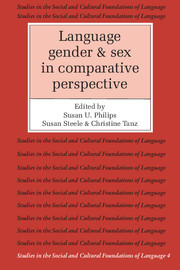Book contents
- Frontmatter
- Contents
- Acknowledgments
- List of contributors
- Introduction: The interaction of social and biological processes in women's and men's speech
- Part I Women's and men's speech in cross-cultural perspective
- Part II Gender differences in the language of children
- Part III Sex differences in language and the brain
- References
- Index
Introduction: The interaction of social and biological processes in women's and men's speech
Published online by Cambridge University Press: 05 June 2012
- Frontmatter
- Contents
- Acknowledgments
- List of contributors
- Introduction: The interaction of social and biological processes in women's and men's speech
- Part I Women's and men's speech in cross-cultural perspective
- Part II Gender differences in the language of children
- Part III Sex differences in language and the brain
- References
- Index
Summary
An important focus of debate within the research on sex differences and language is the extent to which social and biological processes each contribute to differences in women's and men's speech and language. The disciplines that contribute research to the study of sex differences and language, particularly anthropology, linguistics, and psychology, have in common a view of human behavior as guided and directed by both biological and social processes. Yet within each discipline researchers tend to espouse either biological or social processes as the cause of gender-differentiated language-related behavior.
A major purpose in collecting the papers to be published as chapters in this book was to bring together disparate treatments of gender differentiation in language and language use, in the hope of gaining insight into the nature of the interaction of social and biological processes in this area. Part I, on cross-cultural studies of gender and language, and Part II, on language socialization, argue that there is enormous diversity in the role of language in the social construction of gender and that socialization effects appear at a very early age. Parents speak differently from each other; they speak differently to boys than to girls; and boys and girls speak differently. These two sections offer convincing testimony of human plasticity and of the ways in which biology does not constrain the nature of gender in human societies.
- Type
- Chapter
- Information
- Language, Gender, and Sex in Comparative Perspective , pp. 1 - 12Publisher: Cambridge University PressPrint publication year: 1987
- 6
- Cited by



